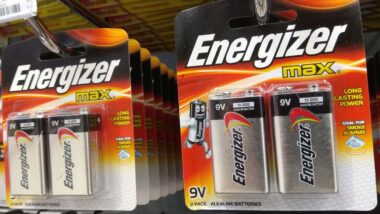Top Class Actions’s website and social media posts use affiliate links. If you make a purchase using such links, we may receive a commission, but it will not result in any additional charges to you. Please review our Affiliate Link Disclosure for more information.

This is the fifth and most recent class action lawsuit filed against Qualcomm since the FTC accused the company of anticompetitive behavior on Jan. 17.
Each of the named plaintiffs in this lawsuit say they purchased several Apple communication devices equipped with modem chipsets (or basebrand processors) manufactured by Qualcomm.
The Qualcomm chipsets allow the device to communicate and transmit voice and data across wireless networks for particular carriers like AT&T and Verizon. It is commonly referred to as Code Division Multiple Access or CDMA technology.
According to the complaint, Qualcomm controls the market for CDMA technology, initially selling 90 percent of the chipsets that go into CDMA-compatible communication devices and continuing to control over 80 percent of the market. This anti-competitive behavior, the consumers say, forces them to pay inflated prices for Apple iPhones and iPads.
“Qualcomm’s anticompetitive conduct, including the abuse of its monopoly power to force device manufacturers and other licensees to pay unreasonably high royalties, has directly harmed Plaintiffs and Class Members in that they have been compelled to pay higher and supracompetitive prices for their cellular phones and other devices than they would have absent Qualcomm’s unlawful conduct.”
Plaintiffs in the Qualcomm antitrust class action lawsuit are proposing to represent a Class that would include all persons in the U.S. who purchased or paid for some or all of the purchase price CDMA and/or premium LTE (4G) cellular devices from Jan. 25, 2013 through the present. Concurrently, the plaintiffs also bring this action seeking monetary relief for a separate nationwide Damages Class.
The lawsuit seeks an award of restitution and disgorgement of profits, along with an injunction permanently enjoining Qualcomm from continuing the alleged anticompetitive conduct.
This most recent lawsuit comes on the heels of several other lawsuits filed against Qualcomm over their alleged anticompetitive conduct.
On Jan. 20, Apple filed a lawsuit in California federal court alleging that Qualcomm’s practices have cost Apple nearly $1 billion in damages.
That complaint follows two other antitrust lawsuits against Qualcomm, one filed by a group of 16 consumers and one seeking more than $145 million in damages that Apple filed last week in China, claiming that Qualcomm violated China’s anti-monopoly law and harmed it by abusing the company’s market position as a dominant chip supplier.
More specifically, the complaints center on Qualcomm’s pricing and patent royalty arrangements for its broadband processors that enable mobile phones to connect with cellular networks.
Qualcomm’s modem chip design was used to help establish standards for the telecom industry. In return for that standardization, Qualcomm committed to licensing those technologies to other companies on FRAND (fair, reasonable and non-discriminatory) terms.
Qualcomm is also facing allegations of unfair and anticompetitive practices by the U.S. Federal Trade Commission. According to an FTC press release, Qualcomm has been using its position as the primary modem supplier for smartphones to get “disproportionately high” patent licensing fees.
Qualcomm allegedly told smartphone manufacturers that if they didn’t agree to the terms, it wouldn’t supply them with modems, which would essentially mean that they couldn’t make a widely available phone, the FTC states.
The consumers are represented by Jason S. Hartley and Jason M. Lindner of Stueve Siegel Hanson LLP; Vincent J. Esades and David Woodward of Heins Mills & Olson PLC; K. Scott Wagner of Wagner Law Group SC; and Patrick R. Burns of Burns Law Firm PLLC.
The Qualcomm Antitrust Class Action Lawsuit is Mackay, et al. v. Qualcomm Incorporated, Case No. 3:17-cv-00148-BAS-NLS, in the U.S. District Court for the Southern District of California.
UPDATE February 23, 2017: Parties on both sides agree with Qualcomm’s request to consolidate at least 24 class action lawsuits into multidistrict litigation.
UPDATE 2: On July 19, 2018, plaintiffs in a Qualcomm antitrust class action lawsuit argued against the chipmaker’s push to require Apple to import iPhones under a proposed cease and desist order pending with the International Trade Commission.
UPDATE 3: On Aug. 9, 2018, Qualcomm fought a motion to certify a class action lawsuit initiated by consumers who say forced import behavior intentionally fixed the price of chipsets commonly used in cell phones. The chipmaker told the court that a Class of 250 million people is unprecedented and unfeasible.
UPDATE 4: On Aug. 29, 2018, a judge blocked a consumer antitrust class action lawsuit that attempted to stop Qualcomm from pursuing a patent infringement case against Apple which could force Apple to only import iPhones with Qualcomm’s chipsets.
UPDATE 5: On Sept. 27, 2018, a group of cellphone purchasers who filed a Qualcomm class action lawsuit have received certification from the court.
UPDATE 6: On Oct. 12, 2018, Qualcomm says that they should be able to appeal a California court’s decision to certify a proposed Class of 250 million individuals in a lawsuit alleging the company gouged consumers by hiking the price of a chip used in most cell phones.
UPDATE 7: On Jan. 23, 2019, consumers who purchased a cell phone since Feb. 11, 2011, may be affected by a Qualcomm antitrust class action lawsuit pending in federal court. A settlement has not been reached and no money is available at this time. However, this litigation is being dubbed “quite likely the biggest class action in history,” and may affect the rights of more than 250 million cell phone owners. Learn more here.
UPDATE 8: On Jan. 23, 2019, Qualcomm was granted an immediate appeal of a massive certified Class of cellphone owners involved in a class action lawsuit alleging the company overpriced chips ubiquitous in mobile devices. Qualcomm contends that the newly certified Class of about 250 million consumers is “simply too large and unwieldy to manage” in a petition to appeal the decision brought to the Ninth Circuit two-judge panel.
ATTORNEY ADVERTISING
Top Class Actions is a Proud Member of the American Bar Association
LEGAL INFORMATION IS NOT LEGAL ADVICE
Top Class Actions Legal Statement
©2008 – 2024 Top Class Actions® LLC
Various Trademarks held by their respective owners
This website is not intended for viewing or usage by European Union citizens.















4 thoughts onQualcomm Class Action Says Consumers Forced to Pay Inflated Prices
I have bought many phones through out the years for my family and for my self.
UPDATE February 23, 2017: Parties on both sides agree with Qualcomm’s request to consolidate at least 24 class action lawsuits into multidistrict litigation.
i did purchase a phone from cricket around about July of 2013 my claim number is 12523916601
Not absolutely sure